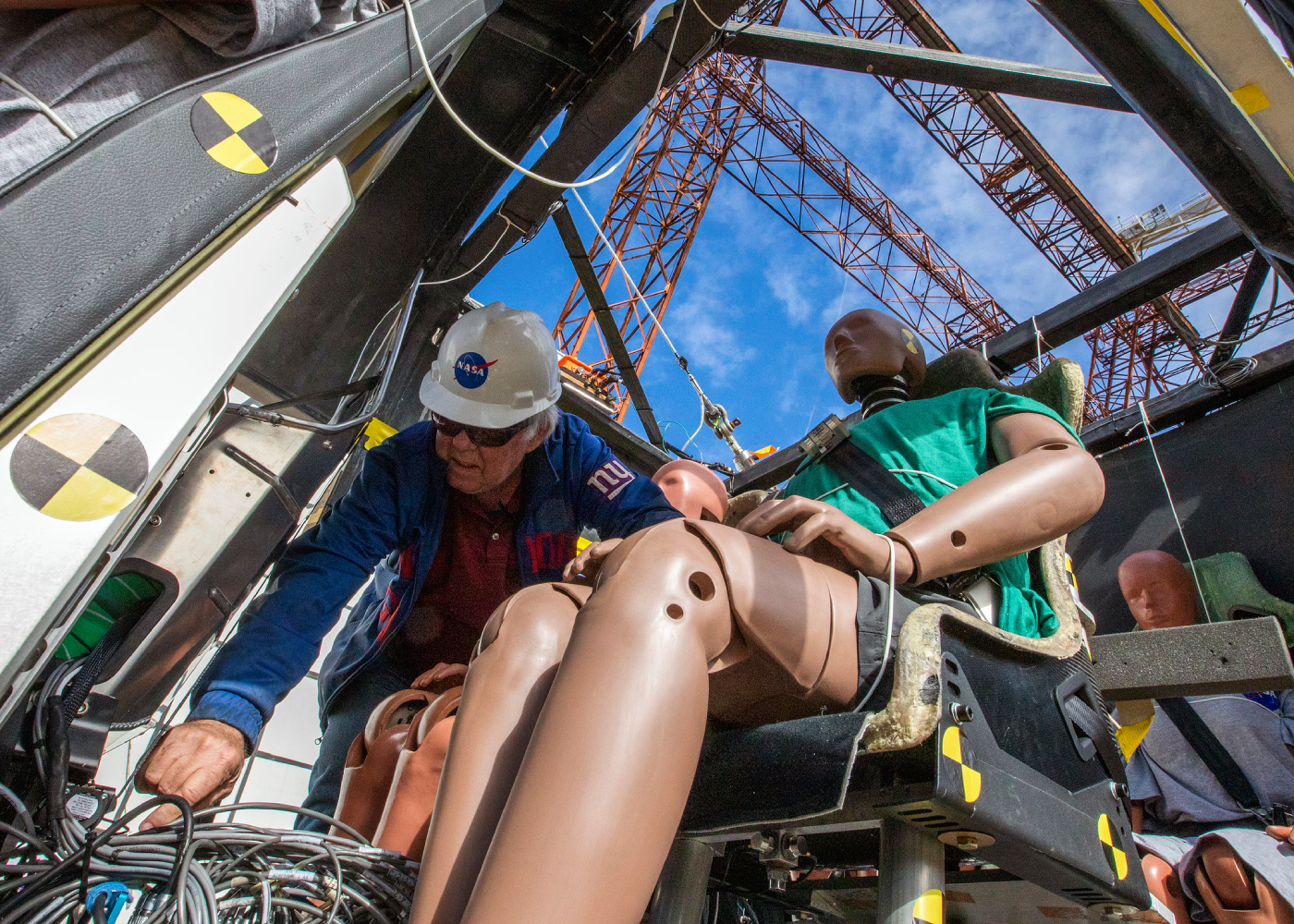High above an outdoor surface at NASA’s Langley Research Center in Hampton, Virginia, researchers dropped a full-sized eVTOL cabin mock-up and sent it hurtling to the ground.
Upon impact, the mock-up’s carbon fiber and resin fuselage buckled, causing the weight-bearing roof to fall into a cabin that carried four crash-test dummies of various sizes.
A portion of the cockpit windshield also shattered, impacting at least one of the two test dummies who represented pilots in a lift-plus-cruise aircraft.
“There may have been some head injury in one of the rear dummies,” said Justin Littell, a research aerospace engineer with NASA.
Data from the test in late 2022 is still being analyzed, and Littell wouldn’t say if any of the simulated injuries were fatal.
But this kind of test will be crucial to establishing crashworthiness standards for eVTOLs, an important next step in the push for their adoption for commercial transport.
“We’re trying to get these done first, so that we can publish this data … and let [aviation authorities] decide what the conditions for crashworthiness may be,” Littell said.
Crushable floors and seats function as intended
Although NASA didn’t anticipate the fuselage collapse in its recent crash test, two important elements of the experiment played out as expected.
First, the aircraft’s NASA-developed composite subfloor crushed on impact, absorbing some of the impact load. And second, a NASA-developed energy-absorbing seat with crushable tubes in the seat legs also crushed as intended, further limiting the impact load on the cabin occupants.
“The load needs to go somewhere, and if the floor doesn’t deform and the seat doesn’t deform, then it goes into the occupants themselves,” Littell said. “That’s where you have a higher risk of injury. The intent of trying to develop all this crushable stuff is to absorb all that load, so the load going into the dummy is much reduced, and that brings it down to survivable levels.”
Lessons may impact crashworthiness standards
It’s important to note NASA’s test results depict what may happen to a very specific type of eVTOL under specific circumstances, and researchers are quick to point out they’re not universal.
Still, they may provide insight that will be useful to manufacturers as they refine their designs.
In this case, NASA tested an aircraft with significant overhead mass, using fixtures meant to represent the wing structure, rotor and battery. They also assumed the entire weight of this overhead structure was over the cabin.
Researchers noted there are many other overhead-mass configurations for eVTOLs that may behave differently in a crash.
Littell also stressed the test didn’t definitively establish where in the airframe eVTOL batteries should be located — another concern as researchers work to determine how batteries may behave in a crash.
“We’re not aircraft designers,” he said. “I know there’s a lot of different designs and … I know everybody’s trying to figure out what is going to go on with these batteries.”
Littell also stopped short of saying crushable floors should be an industry best practice. The key is using tactics that minimize the impact load on pilots and passengers to avoid injuries.
“Anything to reduce the load of the occupant is a good idea to use, whether that’s a crushable floor, crushable seat or crushable landing gear,” he said. “I would say anything you can get in there is obviously helpful and beneficial, because it does take out that load from the impact and reduces it into the occupants.”
Second crash test planned for 2023
NASA intends to publish the results of its 2022 crash test later this year, with plans for another crash test sometime in 2023.
The parameters of the next test are still being determined, but Littell said they will change the seats, using some combination of rigid seats and energy-absorbing models. NASA also wants to continue to optimize its sub-floors and reduce the lumbar loads on crash test dummies, he said.
They may also test the effect of a rigid sub-floor in comparison to a crushable version, and may shift the position of overhead load so there is less weight over the cabin.
“I don’t know what it’s going to look like but it’s going to be a combination of stuff we’ve learned and stuff that we haven’t already tried,” Littell said. “That, along with our computer simulations, will hopefully get a nice, large, dataset which can be used.”





